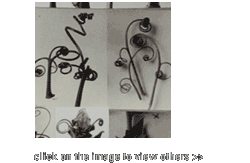December
2002
Karl Blossfeldt, a botanist, sculptor and art professor who
used photography as a teaching implement along with drawing,
plaster and bronze models. He became famous in 1929 almost by
chance, when his photographs perfectly matched the agenda of
the New Objectivity school in Germany. Blossfeldt's book
Urformen der Kunst (Art Forms in Nature) was an
instant bestseller, and the photographs were shown along with
those of the young avant-garde at the famous 1930 Stuttgart
exhibition " Film und Foto ." |
 |
|
Blossfeldt's large , heavily retouched and impeccably printed
photographs show stylized details of plants in close-ups.
There is always only one per image, floating rootless and
shadowless against a white background. The plant specimens
give a feeling of weightless -ness while also resembling fragments
of architecture or wrought iron ornaments. It is as if they
were precariously poised between art and nature.
Until the last few years we knew nothing of Blossfeldt's working
methods. The discovery in his archive of sixty-one work sheets
made of cut-up contact sheets glued onto grey cardboard gives
us a window on Blossefeldt's creative process while he worked
on his book from 1926 to 1928.
To a modern eye the collages acquire the quality of works
of art: the eye travels along grids of multiple views of the
same plant (or plants in the same family) printed on several
types of photographic paper: the gray of the gelatine silver
chloride play against the blue of the cyanotypes and the bronze
of the bromide prints. Pencil notations and numbers in Blossefeldt's
hand add to the visual appeal of the collages and evoke Brassai's
contact print sheets for his study of Picasso's sculptures
as well as conceptual artists such as Bernd and Hilla Becher
or Sol LeWitt.
This book also raises questions about artistic legacy : what
happens to a body of work after the artist has disappeared?
For Blossfeldt himself the collages were only part of a long
working process , a stage in his metamorphosis of the plant
into ornamental form. The profound shift of perspective within
the art world that led to the appreciation and publication
of his work sheets as a book would have been, to him, certainly
incomprehensible and possibly horrifying. So we may ask if
an artist must have control of his work, or if it ultimately
belongs to all of us. As we are touched by this book's beauty,
there is no easy answer.
-- Carole Naggar
Edited by Ann & Jûrgen Wilde
Introduction by Ulrike Meyer Stump
MIT Press, Cambridge
$38.50
|





